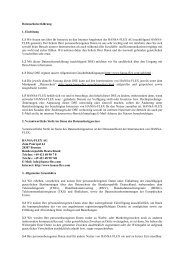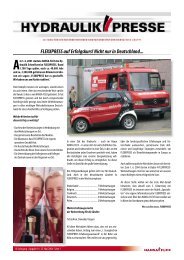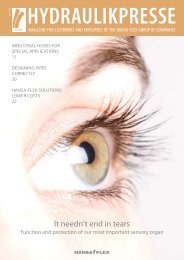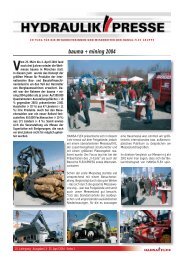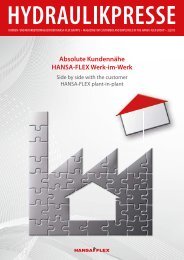Absolute Kundennähe HANSA-FLEX Werk-im-Werk
Absolute Kundennähe HANSA-FLEX Werk-im-Werk
Absolute Kundennähe HANSA-FLEX Werk-im-Werk
Erfolgreiche ePaper selbst erstellen
Machen Sie aus Ihren PDF Publikationen ein blätterbares Flipbook mit unserer einzigartigen Google optimierten e-Paper Software.
<strong>HANSA</strong>-<strong>FLEX</strong> LÄNDER-LEXIKON <strong>HANSA</strong>-<strong>FLEX</strong> COUNTRY LEXICON<br />
<strong>HANSA</strong>-<strong>FLEX</strong> COUNTRY LEXICON <strong>HANSA</strong>-<strong>FLEX</strong> LÄNDER-LEXIKON<br />
In dieser Ausgabe führt uns das <strong>HANSA</strong>-<strong>FLEX</strong> Länderlexikon ans Schwarze<br />
Meer nach Rumänien. Es ist ein faszinierendes Land zwischen Tradition<br />
und Moderne, welches außerdem die He<strong>im</strong>at einer der berühmtesten Romanfiguren<br />
der Neuzeit ist: Bram Stokers Dracula.<br />
Foto/Photo: iStockphoto<br />
GEOGRAPHIE<br />
Rumänien hat 19 Millionen Einwohner, verteilt auf eine Fläche von 237.000 Quadratkilometer.<br />
Das Land liegt <strong>im</strong> Südosten Europas und grenzt an Bulgarien, Ungarn,<br />
Moldawien, Serbien, Montenegro und die Ukraine. Die Hauptstadt Bukarest<br />
hat knapp zwei Millionen Einwohner und ist die größte Stadt des Landes. Rumänien<br />
ist seit 2007 EU-Mitglied, Währung ist der Leu. Große Teile Rumäniens werden<br />
von den Karpaten durchzogen – dort steht mit dem Moldoveanu der höchste Berg<br />
des Landes mit 2.544 Metern Höhe. Nördlich und westlich dieses Mittelgebirges<br />
befindet sich das Siebenbürgische Becken, östlich davon die Pannonische Tiefebene.<br />
Insgesamt gibt es in Rumänien über 3.400 Seen, der größte Fluss ist die Donau<br />
mit einer Länge von 1.075 Kilometer.<br />
FLORA UND FAUNA<br />
Rund ein Drittel Rumäniens ist bewaldet, hauptsächlich mit Misch-, Buchen- und<br />
Eichenwäldern. Im Flussdelta der Donau gibt es viele Sumpf- und Schilfpflanzen,<br />
darunter einige fleischfressende Pflanzen. Die Tierwelt ist vielfältig: In vielen Gebirgswäldern<br />
leben Wölfe, Bären, Hirsche, Wildkatzen und Luchse. Rund um die<br />
Donau gibt es vor allem Wildschweine, Füchse, Fischotter und Biberratten. Die Vogelwelt<br />
umfasst unter anderem Pelikane, Flamingos, Kormorane und Reiher – vor<br />
der Küste leben sogar Delphine und Mönchsrobben.<br />
KLIMA<br />
Rumänien befindet sich <strong>im</strong> Übergang vom marit<strong>im</strong>en- zum kontinentalen Kl<strong>im</strong>a.<br />
Im Zentrum und <strong>im</strong> Westen des Landes herrscht ein feuchtes Kl<strong>im</strong>a. Im Südosten<br />
Ein malerischer Blick auf die Karpaten. Hier befindet sich auch die links zu sehende Burg<br />
Bran, welche angeblich die He<strong>im</strong>at Vlad Drăculeas sein soll. Historisch ist das aber nicht belegt.<br />
An enchanting view of the Carpathians, which are also the site of Bran Castle, pictured at left.<br />
Bran Castle is reputed to be the former home of Vlad Dracula, but the cla<strong>im</strong> is as yet unproven.<br />
gibt es eher kontinentale Einflüsse mit heißen Sommer- und kalten Wintermonaten.<br />
Tief <strong>im</strong> Südosten hingegen ist das Wetter mediterran. Die Temperaturen<br />
können von über plus 40 Grad Celsius bis zu minus 40 Grad Celsius variieren.<br />
GESCHICHTE<br />
Das heutige Rumänien wurde <strong>im</strong> vierten Jahrtausend vor Christus besiedelt. Zunächst<br />
waren es Indo-Europäer, dann Griechen und ab dem ersten Jahrhundert<br />
Römer, die Rumänien prägten. In den folgenden Jahrhunderten standen Teile des<br />
Territoriums unter bulgarischer, tatarischer und ungarischer Herrschaft. Ab dem<br />
14. Jahrhundert behaupteten sich die Walachei und Moldau als eigenständige<br />
Fürstentümer. Die Walachei und Moldau haben sich 1862 als Rumänien zu- g<br />
IM LAND DES<br />
GRAFEN DRACULA<br />
THE LAND OF<br />
COUNT DRACULA<br />
Text: André Tucic<br />
Rumänien<br />
Romania<br />
In this issue, the <strong>HANSA</strong>-<strong>FLEX</strong> country lexicon takes us to Romania, on the<br />
shores of the Black Sea. Romania is a fascinating country, steeped in tradition<br />
yet striving for modernity, which also happens to be the home of one<br />
of the most infamous creations in modern literature: Bram Stoker’s Dracula.<br />
GEOGRAPHY<br />
Romania has a population of 19 million and an area of 237,000 square kilometres.<br />
It is situated in the southeastern extremity of Europe and shares borders with Bulgaria,<br />
Hungary, Moldova, Serbia, Montenegro and the Ukraine. With a population<br />
of two million, its capital Bucharest is also the country’s largest city. Romania has<br />
been a member of the EU since 2007. Its currency is the leu. Much of Romania<br />
is dominated by the Carpathian Mountains – this mountain range includes the<br />
Moldoveanu, the highest mountain in the country which rises to an altitude of<br />
2,544 metres. These highlands are bounded in the North and West by the Transylvanian<br />
Basin and by the Pannonian Plain in the East. In all, there are over 3,400<br />
lakes in Romania, its largest river is the Danube, with a length of 1,075 kilometres.<br />
FLORA AND FAUNA<br />
About a third of the country is forested, mostly mixed, beech and oak forests. The<br />
delta of the River Danube is home to a wide variety of marsh plants and reeds,<br />
including several carnivorous plants. The an<strong>im</strong>al life in Romania is very diverse:<br />
Wolf, bear, deer, wildcat and lynx roam the highland forests. The area around the<br />
Danube provides habitat particularly for wild boar, foxes, otters and coypu. The<br />
bird life includes pelicans, flamingos, cormorants and cranes as well as other species<br />
– even dolphins and monk seals live in the sea off the coast of Romania.<br />
CLIMATE<br />
Romania is located at the transition between the marit<strong>im</strong>e and continental cl<strong>im</strong>ate<br />
regions. In the centre and West of the country, the cl<strong>im</strong>ate is mainly humid.<br />
The Southeast is characterised more by continental influences, with hot summers<br />
and cold winters. In contrast, the weather in the deep Southeast is Mediterranean.<br />
Temperatures can vary between over 40 degrees Celsius above and 40 degrees<br />
below freezing.<br />
HISTORY<br />
The area that is modern Romania was first settled four millennia before the birth<br />
of Christ. The first settlers to make their mark on the region were Indo-Europeans,<br />
who were followed by Greeks, and after the first century by Romans. In the centuries<br />
that followed, parts of the territory fell under the domination of the Bulgars,<br />
the Tatars and the Magyars. Beginning in the 14th century, Wallachia and Moldavia<br />
established themselves as independent principalities. Wallachia and Moldavia<br />
merged to form Romania in 1862. The new country’s independence was recognised<br />
at the Congress of Berlin 16 years later. During the First World War, Romania<br />
allied itself with the powers of Russia, Great Britain and France. After winning its<br />
war against Hungary, Romania almost doubled its land area. But with the outbreak<br />
of the Second World War Romania lost part of its territory as a conse- g<br />
28 2|2013 HYDRAULIKPRESSE<br />
Foto/Photo: iStockphoto<br />
HYDRAULIKPRESSE 2|2013<br />
29



